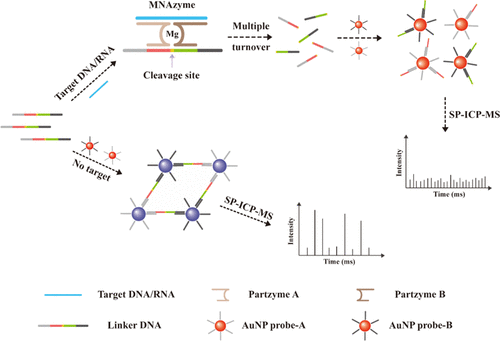当前位置:
X-MOL 学术
›
Anal. Chem.
›
论文详情
Our official English website, www.x-mol.net, welcomes your
feedback! (Note: you will need to create a separate account there.)
A Homogeneous Multicomponent Nucleic Acid Enzyme Assay for Universal Nucleic Acid Detection by Single-Particle Inductively Coupled Plasma Mass Spectrometry
Analytical Chemistry ( IF 6.7 ) Pub Date : 2021-03-09 , DOI: 10.1021/acs.analchem.0c05444 Xiao Yin 1 , Beibei Chen 1 , Man He 1 , Bin Hu 1
Analytical Chemistry ( IF 6.7 ) Pub Date : 2021-03-09 , DOI: 10.1021/acs.analchem.0c05444 Xiao Yin 1 , Beibei Chen 1 , Man He 1 , Bin Hu 1
Affiliation

|
Single-particle inductively coupled plasma mass spectrometry (SP-ICP-MS) has great potential for sensitive analysis of nucleic acids; however, it usually requires separation of target-induced nanoparticle reporters, and the sequence of probes on nanoparticle reporters has to be tuned for each target accordingly. Here, we developed a homogeneous multicomponent nucleic acid enzyme (MNAzyme) assay for universal nucleic acid detection. The two components of MNAzyme contain target recognition sites, substrate binding sites, and a catalytic core. Only in the presence of a specific nucleic acid target, the MNAzyme will assemble to trigger its nucleic acid enzyme activity and cleave its substrate (Linker DNA). The Linker DNA could link gold nanoparticle (AuNP) probes to form a larger assembled particle, while the cleavage of Linker DNA will disturb the linkage between probes, inducing a smaller assembled particle. The assembled particles with different sizes could be differentiated and sensitively detected in SP-ICP-MS, which also enables the tolerance of a complex matrix. By simply altering the sequences of the target recognition sites in MNAzyme, we applied the assay for two types of nucleic acids (long strand DNA and short strand RNA), malaria DNA and miRNA-10b. With increasing the target concentration, the signal intensity of each assembled particle decreases, but the frequency of assembled particle pulse increases. Both targets could be quantitatively detected from 0.1 to 25 pmol L–1 with high specificity in serum samples. The developed MNAzyme–SP-ICP-MS assay possesses simple operation in a homogeneous reaction, easy tunability for multiple types of nucleic acid targets, and good compatibility with clinic samples.
中文翻译:

单颗粒电感耦合等离子体质谱法检测通用核酸的均相多组分核酸酶测定
单颗粒电感耦合等离子体质谱法(SP-ICP-MS)具有对核酸进行灵敏分析的巨大潜力。然而,它通常需要分离靶标诱导的纳米颗粒报道分子,并且必须相应地针对每个靶点调节纳米颗粒报道分子上的探针序列。在这里,我们开发了一种用于通用核酸检测的均质多组分核酸酶(MNAzyme)分析方法。MNAzyme的两个组件包含目标识别位点,底物结合位点和催化核心。仅在存在特定核酸靶标的情况下,MNAzyme才会组装以触发其核酸酶活性并切割其底物(连接子DNA)。接头DNA可以将金纳米颗粒(AuNP)探针连接起来,形成更大的组装颗粒,而连接子DNA的切割会干扰探针之间的连接,从而产生较小的组装颗粒。在SP-ICP-MS中可以区分并敏感地检测出具有不同尺寸的组装粒子,这也使得复杂基质的耐受性得以提高。通过简单地改变MNAzyme中靶标识别位点的序列,我们对两种类型的核酸(长链DNA和短链RNA),疟疾DNA和miRNA-10b进行了测定。随着目标浓度的增加,每个组装粒子的信号强度降低,但是组装粒子脉冲的频率增加。可以从0.1到25 pmol L定量检测两个目标 在SP-ICP-MS中可以区分并敏感地检测出具有不同尺寸的组装粒子,这也使得复杂基质的耐受性得以提高。通过简单地改变MNAzyme中靶标识别位点的序列,我们对两种类型的核酸(长链DNA和短链RNA),疟疾DNA和miRNA-10b进行了测定。随着目标浓度的增加,每个组装粒子的信号强度降低,但是组装粒子脉冲的频率增加。可以从0.1到25 pmol L定量检测两个目标 在SP-ICP-MS中可以区分并敏感地检测出具有不同尺寸的组装粒子,这也使得复杂基质的耐受性得以提高。通过简单地改变MNAzyme中靶标识别位点的序列,我们对两种类型的核酸(长链DNA和短链RNA),疟疾DNA和miRNA-10b进行了测定。随着目标浓度的增加,每个组装粒子的信号强度降低,但是组装粒子脉冲的频率增加。可以从0.1到25 pmol L定量检测两个目标 随着目标浓度的增加,每个组装粒子的信号强度降低,但是组装粒子脉冲的频率增加。可以从0.1到25 pmol L定量检测两个目标 随着目标浓度的增加,每个组装粒子的信号强度降低,但是组装粒子脉冲的频率增加。可以从0.1到25 pmol L定量检测两个目标–1在血清样品中具有高特异性。发达的MNAzyme-SP-ICP-MS分析方法在均相反应中具有简单的操作,对多种类型的核酸靶标的易调节性以及与临床样品的良好相容性。
更新日期:2021-03-23
中文翻译:

单颗粒电感耦合等离子体质谱法检测通用核酸的均相多组分核酸酶测定
单颗粒电感耦合等离子体质谱法(SP-ICP-MS)具有对核酸进行灵敏分析的巨大潜力。然而,它通常需要分离靶标诱导的纳米颗粒报道分子,并且必须相应地针对每个靶点调节纳米颗粒报道分子上的探针序列。在这里,我们开发了一种用于通用核酸检测的均质多组分核酸酶(MNAzyme)分析方法。MNAzyme的两个组件包含目标识别位点,底物结合位点和催化核心。仅在存在特定核酸靶标的情况下,MNAzyme才会组装以触发其核酸酶活性并切割其底物(连接子DNA)。接头DNA可以将金纳米颗粒(AuNP)探针连接起来,形成更大的组装颗粒,而连接子DNA的切割会干扰探针之间的连接,从而产生较小的组装颗粒。在SP-ICP-MS中可以区分并敏感地检测出具有不同尺寸的组装粒子,这也使得复杂基质的耐受性得以提高。通过简单地改变MNAzyme中靶标识别位点的序列,我们对两种类型的核酸(长链DNA和短链RNA),疟疾DNA和miRNA-10b进行了测定。随着目标浓度的增加,每个组装粒子的信号强度降低,但是组装粒子脉冲的频率增加。可以从0.1到25 pmol L定量检测两个目标 在SP-ICP-MS中可以区分并敏感地检测出具有不同尺寸的组装粒子,这也使得复杂基质的耐受性得以提高。通过简单地改变MNAzyme中靶标识别位点的序列,我们对两种类型的核酸(长链DNA和短链RNA),疟疾DNA和miRNA-10b进行了测定。随着目标浓度的增加,每个组装粒子的信号强度降低,但是组装粒子脉冲的频率增加。可以从0.1到25 pmol L定量检测两个目标 在SP-ICP-MS中可以区分并敏感地检测出具有不同尺寸的组装粒子,这也使得复杂基质的耐受性得以提高。通过简单地改变MNAzyme中靶标识别位点的序列,我们对两种类型的核酸(长链DNA和短链RNA),疟疾DNA和miRNA-10b进行了测定。随着目标浓度的增加,每个组装粒子的信号强度降低,但是组装粒子脉冲的频率增加。可以从0.1到25 pmol L定量检测两个目标 随着目标浓度的增加,每个组装粒子的信号强度降低,但是组装粒子脉冲的频率增加。可以从0.1到25 pmol L定量检测两个目标 随着目标浓度的增加,每个组装粒子的信号强度降低,但是组装粒子脉冲的频率增加。可以从0.1到25 pmol L定量检测两个目标–1在血清样品中具有高特异性。发达的MNAzyme-SP-ICP-MS分析方法在均相反应中具有简单的操作,对多种类型的核酸靶标的易调节性以及与临床样品的良好相容性。


















































 京公网安备 11010802027423号
京公网安备 11010802027423号